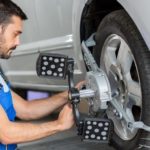
Car seats are made from many different types of material: leather, vinyl, cloth, mesh, and others. This is an important consideration to make when determining how to dry car seats winter. Some materials will dry more quickly than others and some may be better suited for the weather conditions in your geographical location.
Drying car seats in winter can present a challenge as it can either take longer or faster depending on the type of material and how much snow or rain there has been.
Table of Contents
How Long Does It Take To Dry A Car Seat?
The process of drying car seats won’t take too long if and only if you pick a warm sunny day to do it. Even after the seats have been completely wet on both sides, the time it takes to dry differs depending on how much moisture was absorbed by the seat’s material.
Find out: How often can you wash your car during winter?!
For instance, car leather will generally absorb more water than cloth, and it will be harder to remove it from the seat without a lot more effort.
To give you an idea, here is the time it takes to dry a car seat depending on the material it’s made from:
- Cloth/farbric: 6 to 12 hours
- Leather: 2-4 hours
- Vinyl: minutes
- Mesh fabric: less than 24 hours
- Alcantara and suede: 8-14 hours
Cloth
Fabric seats are commonly found in most standard and economy vehicles due to their lower cost and favorable comfort. Yet, they tend to absorb moisture quickly, especially when exposed to liquids such as spills, sweat, or rainwater.
On average, depending on the thickness and density of the fabric, it can take anywhere between 6 to 12 hours for fabric car seats to air dry under regular conditions.
Keep in mind that higher humidity or colder temperatures may prolong the drying process. Ensuring proper ventilation and using a hairdryer, air blower, or heater can considerably reduce the timeframe to as low as 2-4 hours.
Leather
Leather seats are popular in high-end luxury vehicles and are known for their sophisticated appearance and durability. However, leather can be vulnerable to moisture, which can damage the material over time if not treated properly. The drying time for leather car seats depends on the thickness and finish of the leather.
Generally, leather seats can take about 2-4 hours to dry under natural conditions. If you want to expedite the drying process without causing damage, you can use a soft, clean cloth to gently dab the seats and then employ a fan or air conditioner to create consistent airflow. Never use a hairdryer directly on leather, as high heat can cause the material to stiffen and develop cracks.
Vinyl
Vinyl seats are often found in commercial vehicles, classic cars, and boats due to their resilient nature and ease of maintenance.
Unlike fabric and leather, vinyl is water-resistant and does not absorb moisture. This feature significantly reduces the drying time, as it only involves wiping the surface with a cloth.
Consequently, vinyl seats can dry within minutes, provided that any water droplets or moisture have been successfully removed.
Mesh
The material is made from polyester, which can absorb liquid quickly, so it dries in less than a day given the weather is nice.
Alcantara and Suede

Alcantara and suede upholstery offer a luxurious and sporty aesthetic combined with excellent grip and comfort. However, these materials are highly sensitive to moisture and may take longer to dry if exposed to liquids. It is crucial to treat any spills or dampness promptly to preserve the material’s integrity.
Under normal circumstances, Alcantara and suede seats may take 8-14 hours to air dry completely.
Wet Car Seats With No Water In It:
Wet car seats after a rainy day can be a big challenge because they are much more slippery and harder to clean. Wet seats can have obvious moisture on the seat’s surface, but it is still hard to determine how much of it there is without testing. This means that you must test each seat for this amount of moisture before putting it away. Always remember one dry car seat will not save you from mold or mildew.
To test your seats, pour a cup of water onto the seat’s surface and allow it to sit for at least an hour. That is a good amount of time to see how much moisture there is without having to take the seat apart. Take the cup of water out and dab it with a paper towel if you see spots or other signs of wetness.
Read more: The ultimate guide for PDR glue sticks you should know!
Methods to Dry Car Seats Winter
When it comes to drying polyester fabric, it’s recommended to allow it to air dry. If using a dryer, it’s important to use the lowest heat setting for the shortest amount of time to avoid shrinkage or loss of color. High heat can even melt the fabric.
The best way to dry out car seats that have been soaking in rain or snow is by placing them in direct sunlight. However, if you don’t have the luck of the sun on that day, here are some methods you can use:
#1 Dry with Towels
The first method is to use towels to dry out car seats. It’ll take a few hours, but it will get the job done.
Step 1: Get absorbent towels ready
To begin, ensure you have a few large, highly absorbent towels at hand. It’s ideal to use microfiber towels as they are known for their excellent moisture absorption properties. Additionally, you may want to have a bucket or bin to store the damp towels, and a vacuum cleaner for removing any debris before you start the process.
Step 2: Lay the towel on the seat
Spread a large towel across the entire surface of the seat, ensuring it is in full contact with the wet areas. It’s essential to cover the entire seat to maximize the absorption of moisture.
Step 3: Apply pressure to the towel
Exert pressure on the towel by either pressing down with your hands or using your body weight by sitting on the towel. This will help the towel absorb the moisture from the car seat more effectively. Pay particular attention to the areas that are especially damp, using more pressure in those areas.
Step 4: Remove and wring out the towel
Once the towel has absorbed as much moisture as possible, remove it from the seat and wring it out well. It’s important to wring out the moisture properly, ensuring that the towel is ready to absorb more water. As you would expect, your towel will become less effective as it reaches its saturation point, so it’s essential to wring it out in order to continue the drying process.
Step 5: Repeat the process with a fresh towel if necessary
Depending on the level of dampness, you may need to repeat the process with a fresh towel. If the first towel becomes too saturated, switch to another dry towel, and continue the process until the majority of the moisture is removed from the seat.
Step 6: Air dry the car seats
Once the towels have absorbed as much moisture as possible, allow the seats to air dry in a well-ventilated area. If possible, park your car in a sunny spot or use a fan to circulate the air around the vehicle. Exposure to natural sunlight and airflow will further help to dry your car seats.
Step 7: Dealing with stubborn damp spots (Optional)
If you still have stubborn damp spots in your car seats after using towels, a hairdryer can come in handy. Ensure you use a low to medium heat setting, and avoid staying on one spot for too long to prevent damaging the car seat fabric.
#2 Vacuum It Out
Another way to dry a wet car seat is by vacuuming it out. Here is the detailed instruction:
Step 1: Remove visible moisture
First, address any visible wetness on the car seats. You can use a towel or a clean, absorbent cloth to blot the wet areas. Be sure to press firmly with the towel to remove as much moisture as possible before moving on to the vacuum.
Step 2: Choose the right vacuum
It’s essential to use a wet-dry vacuum cleaner specifically designed for sucking up liquids. Using a regular vacuum cleaner is not only ineffective but could also damage the device. Wet-dry vacuums, also referred to as shop vacuums, are commonly available at home improvement stores or online marketplaces.
Step 3: Attach the right nozzle
Remove the vacuum’s regular floor nozzle and attach the upholstery nozzle, which is usually smaller and designed for cleaning furniture and car interiors. This nozzle will provide better suction and maneuverability on the car seats, enabling you to remove moisture more effectively.
Step 4: Test the vacuum
Before applying it to the entire seat, test the vacuum on a small, inconspicuous spot to ensure that it will not harm or discolor the fabric.
Step 5: Vacuum the car seats

Start vacuuming the wet car seats, focusing on the damp areas. Apply firm and steady pressure with the vacuum nozzle and move slowly over the entire surface. Going too fast may reduce the vacuum’s effectiveness in removing moisture. For best results, take your time to ensure that all the moisture is addressed.
Step 6: Repeat if necessary
Once you’ve finished vacuuming the car seats, assess if they’re still damp. Depending on the severity of the wetness or the type of seat fabric, you may need to repeat the vacuuming process.
Step 7: Air it out
Once you’ve used the vacuum to remove as much moisture as possible, it’s essential to allow the car seats to air out. Even in the winter, try to crack open the windows or doors for some time to promote air circulation and help the seats dry naturally. If it’s sunny, park your car in direct sunlight to speed up the drying process further.
Step 8: Dehumidify the car
If your car is excessively damp in the winter, consider using a portable dehumidifier or moisture-absorbing products, such as silica gel packets or charcoal bags. These can be placed in the car to help control humidity levels and prevent mold and mildew growth.
#3 Drip-Drying Your Seats
If you’re going to hang out your car seats to dry in the sun or any other place, drip-drying is a good option. It’s a neat little trick that will save you money on heating and electric bills. Plus, when you drip dry your wet car seats, they won’t be sitting around for too long since the sun will only have to dry them for a few hours.
To drip-dry car seats, it’s recommended to use towels to remove as much moisture as possible, then leave the car in a well-ventilated area to air dry. Using a fan or air mover may also help to speed up the process.
#4 Leave the Fans On
If you have a cold car seat, it’s best to leave the fan on overnight for safety. This is not an immediate method that will dry your seats in one night, but it is the safest way to ensure that they are completely dry in a few days.
#5 Try an Air Mover
The last thing you want to do is leave your car seats out and not have direct sunlight either. That’s why a great way to dry out your wet car seats is by using an air mover. It blows hot air around the seat and can speed up the drying process.
In order to effectively dry car seats with an air mover in winter, it is important to first consider the temperature and humidity levels within the space. The air mover should be placed in a warm, dry area of the car, such as on top of the dashboard or near a window.
It is important to make sure that no cold air enters the vehicle while using it so that the temperatures remain consistent.
Additionally, it may be beneficial to use a dehumidifier in order to reduce the moisture in the air. Once these conditions are met, turn on the air mover and point it towards each seat in turn.
The air mover should be directed at each seat for approximately ten minutes at a time before moving onto the next seat. If there are any particularly wet areas, they should have more directed airflow for longer periods of time until they are dry.
After each seat has been treated with an air mover, allow them to sit for several hours before driving or re-entering into the vehicle.
How to Dry Car Interior in Winter
In winter, drying the interior of your car can be a tricky task.
First and foremost, it is important to protect yourself from cold conditions by wearing appropriate clothing, such as gloves and a hat. Additionally, it is important to open all doors, windows and sun roofs when drying your car interior so that air can circulate freely throughout the vehicle.
- Start by wiping down any leather surfaces with a microfiber cloth. This will help to remove dirt and dust from the surface of your car’s leather whilst also helping to maintain its natural shine.
- For cloth seat covers or carpets, you can use either a vacuum cleaner or handheld steam cleaner to effectively remove dirt and debris.
- Once this has been completed, you can use an interior detailing spray designed specifically for cars to provide a further deep cleanse. This type of product should be applied liberally and allowed to sit for 5 minutes before being wiped off with a dry microfiber cloth.
It is also important to ensure that your car’s interior remains dry during the winter months. If possible, park in covered areas such as garages or under trees when leaving the car unattended.
Also, consider placing absorbent towels on any surfaces which may be exposed to condensation or dampness from wet weather conditions outside. These will help soak up any moisture before it has time to damage surfaces inside your vehicle. Absorbent towels are also a great way to protect fabric surfaces from stains and spills.
For details, you can check out this video:
FAQs
#1 Does Baking Soda Draw Out Moisture?
Baking soda, a common household product found in many kitchens, uses baking soda to absorb water and help dry out wet items. In fact, it’s so effective that it has been used in the home for more than 100 years!
The dryer method can be done by sprinkling baking soda onto the seat and allowing it to sit for an hour. As with any other cleaning method, never use baking soda to wash your car seats, as they are designed to be cleaned with water only.
#2 Does Borax Draw Out Odor?
Most car seats are made from fabrics and plastics that are not very porous. However, if you do use any type of borax in your car seat, the fiberglass can absorb the leftover moisture.
This can lead to both bad odor and mold when you try to clean it. Although borax may seem like a good idea, better options include baking soda or even a vacuum pile with a wet sponge.
#3 Why Are My Car Seats Damp?
Snow and rain happen more often in winter, which means you want the temperature to be above freezing to avoid any water getting into your car’s seats. A good way to do this is by using a cover, especially if you live in a place that experiences a lot of snow and rain.
#4 What is the Fastest Way to Dry Car Seats Without a Vacuum?
The fastest way to dry car seats without a vacuum is by using compressed air. Air compressors are able to generate a powerful stream of air, which can easily remove water from upholstery and other surfaces. This type of compressed air can reach deep into the crevices of car seats and other hard-to-reach places, making it an effective method for drying out wet fabric.
Moreover, you may want to use a large towel or rag along with the air compressor to help absorb larger amounts of residual moisture from the car seat.
#5 How Do I Get the Moisture out Of the Car in Winter?
During the winter, getting moisture out of a car can be achieved through several methods. Place moisture-absorbing products like silica gel or desiccant packs inside the car, or use a small dehumidifier if electricity is available.
Ensure that wet items are removed and excess moisture is avoided. Set the car’s ventilation to fresh air intake mode, use the defroster, and crack open windows for improved air circulation.
How to Dry Car Seats in Winter Conclusion
As you can see, all car seats are different, so drying them requires more than just a few hours. If you need to dry out your car seat immediately, consider using paper towels and dabbing the moisture. However, make sure that it is completely dry before placing anything on it.
Find out: Ways to wash your car without any car scratches!
If you want to save time and money, try using a towel or cloth instead of paper since they are much cheaper and safer for the seats.
Further Reading:
Hi everyone, My name is Ollie Barker.
As a seasoned auto expert I have 25 years of experience working in repair and detailing shops. I love to share my tips & tricks to all car lovers, so that’s why I’m here at Automotive Gearz publishing my content, sharing my passion. Also, I’ve been giving my recommendations on which products are the best to have on the market. I always thought it was hard to pick the right part, so hopefully I can make that a bit easier for you.
Hope you enjoy your time on my little blog!







